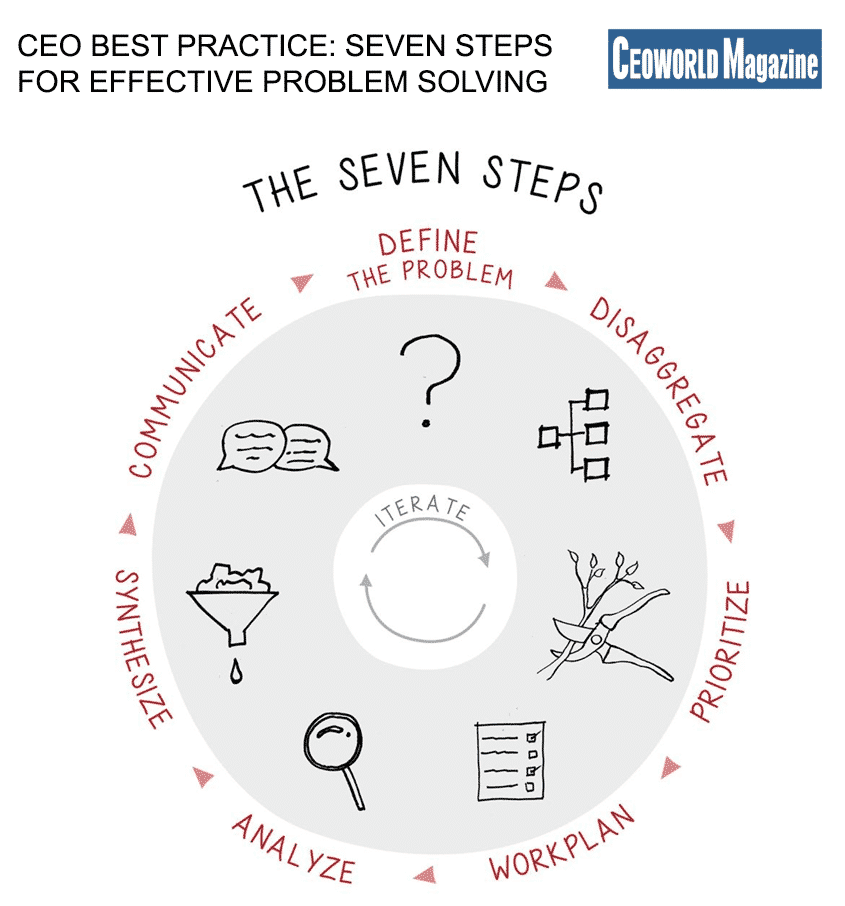Problem Solving Is A Critical CEO Issue

Two dramatic findings highlight the importance of individuals and corporations developing strong problem-solving skills, and their place in the CEO agenda:
- Organizations with strong problem-solving capability have total return to shareholders 3.5 times higher than that of their bottom quartile counterparts over a 3 year period.
- The World Economic Forum lists complex problem solving as the top 10 skill for 2020.
Why has problem solving become a CEO issue? And what should CEOs do about it?
It is a discussion that should get much more attention both within our organizations and in our universities. Problem solving of course hasn’t gone unnoticed among CEOs and educators.

Leaders such as Dominic Barton, Global Managing Partner Emeritus of McKinsey and Company says, “Problem solving is the core skill of the twenty-first century,” while Eric Schmidt, former Chairman and CEO of Google says, “We always hired for creative problem solving talent above all else.” Barry Nalebuff at the Yale School of Management says, “Great strategic problem solving is an essential tool, one whose value is only going up.”
We have met few CEOs of public companies, tech ventures or non- profits who weren’t good problem solvers themselves. On the other hand, most feel their organizations could be a lot better at problem solving. There is a plausible explanation for this difference between a CEO’s capability and that of his or her organization. It lies in changing the factors for success in corporations.
Why problem solving has become a CEO issue
There is a compelling argument for why problem solving has been elevated to the C-suite. It is both because the problems facing CEOs are larger and more complex, and because business models are rapidly becoming disrupted, changing faster than ever before. When we look at what corporate success involves it is clear that it is increasingly a function of people assets rather than physical assets, and that the people assets emphasis needs to be on problem solving capability and teamwork. However neither secondary school, university or corporate training provides requisite skills in problem-solving.
Our experience is that there are pitfalls and common mistakes in problem solving in organizations that have to be addressed with a more systematic process. They include:
- Weak problem statements. Too many problem statements lack specificity or clarity about decision-maker criteria and constraints, or action that will occur if the problem is solved. It’s often said that a problem well defined is a problem half solved. And it could be said that an ill-defined problem is one unlikely to be solved.
- Asserting the answer. The assertion is typically based on a senior manager’s experience where an analogy becomes the solution. The analogy may be sound up to a point but needs to be challenged for validity in the particular setting. The approach we propose instead is to draw a hypothesis about the answer from a well framed problem statement.
- Failing to disaggregate the problem in the right way. Finding the right cleaving point for a problem is often key to the solution. In an M&A mining project I led, the team developed a hypothesis that undeveloped mine leases might be key to the net present value of the resource. Accordingly, they cleaved the problem around the value of the existing mine and the value of development options. The development options turned out to be of higher value than the existing mine. Few problems can be solved without disaggregation into component parts, and the right parts.
- Diverse teams and team norms. Our experience in teams at McKinsey and other organizations highlight having diversity of experience among the team, and having divergent views among team members, who are prepared to express their views. Problems arise where hierarchy or groupthink prevail.
- Using the wrong analytic tools. The tools need to be appropriate to the task at hand. If a team is trying to understand causes it should employ root cause tools, regression or experiments. If you wish to predict outcomes machine learning and search algorithm optimization are the right tools.
- Failing to link conclusions with a storyline for action. Many teams view their work as done when they complete analysis. The final step required is to synthesize findings and develop a narrative for action. Only then is a problem on the way to being solved.
If these traits sound familiar in your organization, you need to take action to improve problem solving capability.
What CEOs Can Do About It
CEOs thrive on setting priorities and taking appropriate action. Elevating problem solving to the point where people are hired for problem solving skills and where the corporation is ranked in the top quartile of problem solvers will require taking the following steps:
- Take stock of the corporation’s problem solving capability. McKinsey has a survey tool in their Organization Health Index (OHI) that allows you to make such a calibration.
- Introduce problem solving criteria into recruiting at all levels. Only then can you signal its importance and begin building problem solving muscle. I met with the CEO of one of the largest philanthropic foundations in the U.S. recently and he attributed the programs having the greatest impact to being staffed by critical thinkers, a key part of problem solving ability, rather than those staffed by domain experts.
- Employ a systematic 7 step process throughout the corporation for all major problem solving tasks, from product development to M&A. The steps are to define the problem, disaggregate and prioritize, build a workplan and team norms, conduct analysis, synthesize findings and communicate them in a way that leads to action. We show the process as a wheel to reflect its iterative nature, and teams may need to reiterate the problem again and again to reach a solution that can be acted upon

CEO Best Practice: Seven Steps For Effective Problem Solving .
- Teach the 7 steps in employee induction so that it becomes part of the way we do things. This serves as reinforcement to the signals set around recruiting for problem solving skills.
- Bring problem solving capability into performance evaluation to highlight its significance and draw attention to areas to improve.
Astute and creative CEOs have demonstrated they can quickly build new capabilities in their organizations, from quality to risk assessment. Problem solving is the next cab off the rank – a priority made more urgent by the abundance of complex problems and disruption in business models.
Have you read?
# World’s Best Countries To Invest In Or Do Business.
# Countries With The Best Quality of Life, 2019.
# Most Startup Friendly Countries In The World.
# The World’s Safest Cities Ranking.
# Global Passport Ranking, 2019.
Bring the best of the CEOWORLD magazine's global journalism to audiences in the United States and around the world. - Add CEOWORLD magazine to your Google News feed.
Follow CEOWORLD magazine headlines on: Google News, LinkedIn, Twitter, and Facebook.
Copyright 2025 The CEOWORLD magazine. All rights reserved. This material (and any extract from it) must not be copied, redistributed or placed on any website, without CEOWORLD magazine' prior written consent. For media queries, please contact: info@ceoworld.biz








